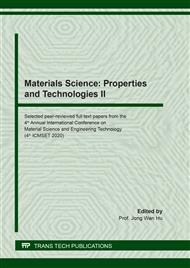[1]
L. Guerrero, (2013), Lime and construction systems. in L. Barba Pingarrón, & I. Villaseñor Alonso, Lime: History, properties and use the LANCIC-IFUNAM, (pp.49-72). Mexico City: National Autonomous University of Mexico, Institute of Anthropological Research, (2013).
Google Scholar
[2]
I. Villaseñor Alonso, L. Barba Pingarrón, (2012), The technical origins of lime, in Cuicuilco, 55, 11-41.
Google Scholar
[3]
Carran, D., Hughes, J., Leslie, A., & Kennedy, C. (2012). A Short History of the Use of Lime as a Building Material Beyond Europe and North America. International Journal of Architectural Heritage: Conservation, Analysis, and Restoration, 6(2), 117-146, (2012).
DOI: 10.1080/15583058.2010.511694
Google Scholar
[4]
M. G. Diaz Calderon, (2017), Organic and inorganic additives in lime mortars: historical revision for the implementation in contemporary interventions. Ms C Tesis, Faculty of Architecture, Universidad Michoacana San Nicolas de Hidalgo, (2017).
Google Scholar
[5]
E. G. Navarro, A. Sanchez, J. A. Bedolla, E. M. Alonso, (2019) High purity lime as an ecologic alternative for buildings finishes, doi:https://doi.org/10.21041/CONPAT2019/V2PAT130.
Google Scholar
[6]
E. G. Navarro Mendoza, (2019), High purity lime in powder presentation as an alternative material in restoration works. Ms C Tesis, Faculty of Architecture, Universidad Michoacana San Nicolás de Hidalgo.
Google Scholar
[7]
Samano Chong, M. (2019). Formulated lime mortars as a sustainable practice for Built Heritage conservation in Mexico. En J. I. Álvarez, J. M. Fernández, Í. Navarro, A. Durán, & R. Sirera (Ed.), 5th Historic Mortars Conference (págs. 1142-1155). Pamplona, Spain: RILEM Publications S.A.R.L.
Google Scholar
[8]
J. A. Bedolla Arroyo, (2008), Mechanical characterization of slaked lime mortars. PhD Tesis, Universidad Michoacana de San Nicolas de Hidalgo.
Google Scholar
[9]
M. Galván-Ruiz, R. Velázquez-Castillo, (2011) Lime, an ancient material as a new option for building, in Ingeniería, Investigación y Tecnología, XII (1), 93-102.
DOI: 10.22201/fi.25940732e.2011.12n1.010
Google Scholar
[10]
R. Fernández Aller, Preámbulo, (2014), Structure of the lime production in Spain, in F. J. Alejandre Sánchez, V. Flores Alés, F. J. Blasco López, & J. J. Martín del Río, Lime. Research, heritage and restoration.
Google Scholar
[11]
Kurugöl, S., & Güleç, A. (2014). Physico-Chemical, Petrographic, and Mechanical Characteristics of Lime Mortars in Historic Yoros Castle (Turkey). International Journal of Architectural Heritage: Conservation, Analysis, and Restoration, 6(3), 322-341. doi:http://dx.doi.org/10.1080/15583058.2010.540072.
DOI: 10.1080/15583058.2010.540072
Google Scholar
[12]
Silva, B. A., Ferreira Pinto, A. P., & Gomes, A. (2015). Natural hydraulic lime versus cement for blended lime mortars for restoration works. Construction and Building Materials, 94, 346-360. doi:http://dx.doi.org/10.1016/j.conbuildmat.2015.06.058.
DOI: 10.1016/j.conbuildmat.2015.06.058
Google Scholar
[13]
Elsen, J. (2006). Microscopy of historic mortars - a review. Cement and concrete research, 36(8), 1416-1424. doi:.
DOI: 10.1016/j.cemconres.2005.12.006
Google Scholar
[14]
Silva, B., Dalla Benetta, M., da Porto, F., & Valluzzi, M. R. (2014). Compression and Sonic Tests to Assess Effectiveness of Grout Injection on Three-Leaf Stone Masonry Walls. International Journal of Architectural Heritage: Conservation, Analysis, and Restoration, 8(3), 408-435.
DOI: 10.1080/15583058.2013.826300
Google Scholar
[15]
Almeida, L., Santos Silva, A., Mirao, J., & do Rosário Veiga, M. (2019), Evolution of mortars composition and characteristics during the 20th century - Study of Portuguese buildings awarded with Architecture Valmor Prize. En J. I. Alvárez, J. M. Fernández, Í. Navarro, A. Durán, & R. Sirera (Ed.), 5th Historic Mortars Conference (págs. 959-972). Pamplona, Spain: RILEM Publications S.A.R.L.
Google Scholar


